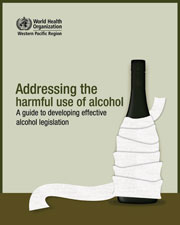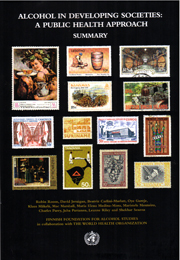
Alcohol use is global health risk factor no three
WHO has released the new estimates on the Global Health Risks, based on the Global Burden of Disease figures from 2004. Alcohol use is risk factor number eight for mortality in the world and the third risk factor for burden of disease.
The new WHO report, "Global health risks", is a comprehensive assessment of leading risks to global health. It provides detailed global and regional estimates of premature mortality, disability and loss of health attributable to 24 global risk factors. The risk factors are identified both with their impact on mortality and the broader meassure of burden of disease as measured in disability-adjusted life years (DALYs). The DALY combines years of life lost due to premature death with years of healthy life lost due to illness and disability.
The leading global risks for mortality in the world are high blood pressure, tobacco use, high blood glucose, physical inactivity, and overweight and obesity.
The leading global risks for burden of disease (DALYs) are underweight and unsafe sex, followed by alcohol use and unsafe water, sanitation and hygiene. According to the report "Three of these risks particularly affect populations in low-income countries, especially in the regions of South-East Asia and sub-Saharan Africa. The fourth risk – alcohol use – shows a unique geographic and sex pattern, with its burden highest for men in Africa, in middle-income countries in the Americas and in some high-income countries."
Five leading risk factors identified in this report (childhood underweight, unsafe sex, alcohol use, unsafe water and sanitation, and high blood pressure) are responsible for one quarter of all deaths in the world, and one fifth of all DALYs. Reducing exposure to these risk factors would increase global life expectancy by nearly 5 years.
The Global Health Risks report uses a comprehensive framework for studying health risks developed for The world health report 2002, which presented estimates for the year 2000. The report provides an update for the year 2004 for 24 global risk factors. It uses updated information from WHO programmes and scientific studies for both exposure data and the causal associations of risk exposure to disease and injury outcomes.
In the previous Global Burden of Disease Study (2002), alcohol was risk factor number five for ill health and premature death globally, accounting for 3,2% of deaths and 4,0% of the total burden measured in Disability Adjusted Life Years (DALYs). In the present study alcohol accounts for 3.8% of mortality and 4,5% of DALYs, ranking it as the third risk factor to ill health and premature death after childhood underweight and unsafe sex. It is noted that differences between these new 2004 estimates and estimates for earlier years previously published by WHO should not be interpreted as representing time trends. Estimates for earlier years are not generally comparable with those for 2004 due to improvements in methods and data.
The new Global Health Risks report have not yet incorporated alcohol as a risk factor for infections disease nor the quantification of this relation, which was established recently. (See separate story: Infectious diseases have alcohol link). These quantifications will come in a later revision of the Global Burden of Disease figures.
Double burden
In a press release WHO draws attention to the combined effect of multiple risk factors. Many deaths and diseases are caused by more than one risk factor and may be prevented by reducing any of the risk factors responsible for them.
The report also points out that health risks are in transition: populations are ageing owing to successes against infectious diseases; at the same time, patterns of physical activity and food, alcohol and tobacco consumption are changing. Low- and middle-income countries now face a double burden of increasing chronic, noncommunicable conditions, as well as the communicable diseases that traditionally affect the poor. Understanding the role of these risk factors is important for developing clear and effective strategies for improving global health
For more information:
WHO press release
WHO webpage with the full report for download
![]()
![]()
Developed with CustomPublish CMS by Nettinfo AS




